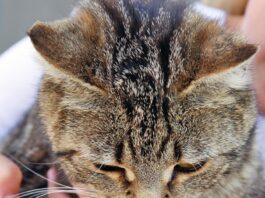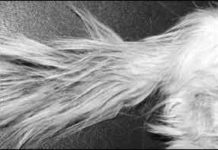Ask Elizabeth: September 2013
I understand why you may want to use these devices for cleaning the air with three kitties in the house, and you are certainly not alone in doing this. Although kitties (and their food and waste) smell great to me, households with cats can sometimes generate odors that some people find objectionable, and there are a number of ways that owners choose to deal with this. Ionic air cleaners are one of the newer technologies that have been developed to address air pollutants.
Ask Elizabeth: August 2013
It’s true that moving to a new location can be exciting, but it can be a source of anxiety for people and their four-legged friends, kitties certainly included. While some tension is unavoidable, there are a few things to consider when determining the safest, most comfortable and least traumatic way of getting your kitties to their new environs.
An Unmistakable Sign of Anal Problems: Scooting
Scent is one of the ways cats communicate, and their anal glands help in that effort. The pea-sized glands, or sacs, produce an odor that aids in establishing identity and territory. When a cat defecates, the scent glands empty through two ducts located at the 4 o’clock and 8 o’clock positions of the anal sphincter, the band of muscle encircling the anus.
When a Sudden Disaster Strikes
Disaster preparedness isn’t only for earthquakes and hurricanes. It’s also vital for everyday occurrences, such as an extended power outage or sudden wildfire racing over the hill. Every 23 seconds, a fire department rushes to a fire somewhere in the U.S., according to the National Fire Protection Association. Are you ready?
Seven Common Grooming Mistakes
Cats enjoy a reputation for being stellar self-groomers, but they reap enhanced health benefits by having their nails trimmed, their coats brushed and, yes, even receiving the occasional bath. To ensure successful at-home grooming, Hayley Keyes, Executive Director of the International Professional Groomers, Inc. and an international master certified professional cat groomer, shares seven tactics to avoid common mistakes. “There are different techniques when it comes to brushing and bathing a cat versus a dog,” says Keyes, who operates the Nanhall Pet Spa/School of Grooming in Greensboro, N.C. “But the bottom line is that you want these grooming times to be safe and stress free for the both of you.”
Why Do They Cover/Uncover the Litter Box?
This occasional series explores the reasons for cats’ often intriguing behavior. If you would like to suggest a topic, please write CatWatch Editor, 800 Connecticut Ave., Norwalk, CT 06854, or email catwatcheditor@cornell.edu. One of the enduring mysteries of cats’ behavior is why they cover their feces after eliminating. One theory is that they’re trying to hide their presence from predators, as cats in the wild are believed to do, but no studies support that idea. Another suggests that the behavior is an indication of cats’ fastidiousness, but that doesn’t explain fastidious cats who leave urine or feces uncovered. The real answers are far more complicated.
Supracaudal Gland Hyperplasia
In teenagers, the sebaceous glands contribute to the development of acne. In cats, these glands can cause a similar problem at the base of the tail, an accumulation of scale (flakes) and yellow-to-black waxy debris (blackheads) along the dorsal, or top, surface of the tail. Although it can affect any cat who doesn’t groom the tail, the condition was once thought to affect only intact male cats, hence the name stud tail, says dermatologist William H. Miller, Jr., VMD, Medical Director of the Cornell University Hospital for Animals.Medically, the condition is known as supracaudal gland hyperplasia or tail gland hyperplasia. It’s caused by hypersecretion of the glands in the supracaudal organ on the base of the tail.
Enhance Healing at Home or the Clinic
Don’t expect your cat to come to you with pleading eyes to book a veterinary appointment when he’s not feeling well. That’s because cats have a validated reputation for being both prey and predator. They’ll do their best not to let anyone know they’re injured or ailing. It’s a survival mindset.
A Commitment to Improving Well-being
Imagine veterinarians being able to sterilize feral cats by vaccination instead of surgery. Or to identify the connection between a relatively benign form of feline coronavirus and feline infectious peritonitis, which is nearly always fatal, with the hope of finding ways to diagnose and combat it. Or discover how and why vaccine-associated sarcomas may trigger DNA damage in some cats and how this damage may be used to predict which cases of the sarcomas are amenable to chemotherapy. These are just three of the many scientific studies funded by the Cornell Feline Health Center where, under the guidance of Director Colin Parrish, Ph.D., Professor of Virology, the goal of bettering the health of cats continues to be the focus and commitment, as it has been since the center opened its doors in 1974.
Ask Elizabeth: October 2012
Toxoplasmosis is caused by the protozoal parasite Toxoplasma gondii, which requires passage through a cat to produce infective oocysts that can subsequently infect other warm-blooded animals. Cats usually acquire toxoplasmosis by eating infected prey, and approximately 20 percent of cats will begin to shed toxoplasma oocysts in their feces after ingesting toxoplasma. Oocysts in cat feces take between 24 and 48 hours to become infective for other animals, so if you are able to remove the feces from your garden within 24 hours (wearing gloves and washing hands thoroughly afterward), you will significantly decrease the likelihood of having your vegetables be a source of toxoplasma infection.
Safeguard Your Pets Against Ticks
Ticks are tenacious. They creep up tall grass, weeds and fences — waiting until a passing shadow, a vibration, an odor or even a whiff of exhaled carbon dioxide tells them a possible host might be passing by. Then they let go of their perch and fall, or reach out with their front legs to snag hold of a furry coat (or a pant leg). Once on board, they insert their mouths into their prey and begin their meal. During this feeding, tick saliva mixes with the host’s blood.
Free Cat Litter for a Worthy Cause
World’s Best Cat Litter™ recently announced that Blind Cat Rescue & Sanctuary of St. Pauls, NC was randomly selected from a fan submission to win the first round of GiveLitter™ for the year. The shelter will receive 2012 pounds of litter that will help its hardworking staff clean up after blind cats currently looking for homes.











